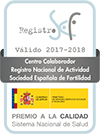Egg donation treatment or IVF with egg donor is an assisted reproduction treatment which helps women affected by fertility problems to fulfill their dream when they cannot achieve it naturally. Thanks to this fertility treatment, an anonymous donor voluntarily donates her oocytes and they are fertilized with the sperm of the recipient’s partner. Egg donation steps are exactly the same as the Conventional In Vitro Fertilization, the only difference is that the donor is the one who is subjected to the egg retrieval and ovarian stimulation.
Egg donation steps

Here are the egg donation steps which:
The first step consists of selecting the most suitable donor for the patient
The selection of the donor is performed in accordance with the current assisted reproduction law in an anonymous and voluntarily way. Every egg donor is screened through different kind of tests and a complete check-up to rule out any important disease which may affect the future baby. Moreover, the maximum phenotypic (physic) and immunologic similarity between the patient and the donor is achieved.
Once the donor is selected, the second step consists of preparing the egg donor which is usually performed by administering oral contraceptives (birth control pills). On the other hand, the donor is subjected to the same ovarian stimulation process and follicular puncture as the Conventional In Vitro Fertilization in order to retrieve the maximum number of oocytes.
The third step is the fertilization in the laboratory
Once the donor’s oocytes are retrieved, they are fertilized with the sperm of the patient’s partner. Subsequently, the embryos which were obtained are cultured.
The fourth step is preparing the patient to the embryo implantation
In this phase, the endometrium of the patient is prepared to receive the embryo implantation. This is achieved through the administration of hormones, especially estrogens and progesterone.
The last and decisive step is the embryo implantation
The embryos are transferred to the womb of the patient through a special cannula. After the embryo implantation, the patient remains at rest for approximately a half an hour, and then she can return to her daily activities.







